Test and optimise LTE 450MHz, without handsets
Amr Ashraf describes the commercial opportunities LTE 450MHz enables, and how to overcome the impact on testing and network optimisation when there are no handsets available on the market.
How do you test and optimise LTE 450MHz, when there are no handsets on the market?
In December, Amr Ashraf, RAN and Software Solution Architect and Trainer at Digis Squared, gave us his insights into LTE 600MHz band and network optimisation. In this blog, he provides an update on the LTE 450MHz band, the commercial opportunities it enables, and how to overcome the impact on testing and network optimisation when there are no handsets available on the market.
The background: why use 400-450 MHz for telecoms?
Amr explains, “Communications in the 400-450 MHz band – also called ‘LTE 450MHz’ – have a longer wavelength, lower frequency, and lower energy than the frequencies used by 5G. They have favourable propagation characteristics, and deliver good coverage (and therefore lower infrastructure costs), along with better in-building penetration.”

Electromagnetic Spectrum, and LTE 400-450 MHz [1]
“Let’s think about how the characteristics of this band can be best commercially used in the telecom sector,
- Coverage and capacity: Due to the physical properties of the frequencies involved, very good indoor penetration and coverage can be achieved with a small number of sites. Compared with higher bands, it requires a smaller number of base stations to give a broad reach, achieving significant economic benefits in covering large areas with a dispersed population.
However, standardised equipment does not support channel bandwidths greater than 5 MHz. As a result, the 400 – 450 MHz band is ideal for networks with high coverage requirements but low to moderate capacity requirements – for example, it enables some very efficient commercial opportunities for low volumes of data sent by IoT devices in rural areas.
Mainstream consumer devices do not include LTE 450MHz support (and are unlikely to do so at any point soon), so this band is also largely free of congestion. It, therefore, has the potential to be used to offload M2M traffic away from premium frequency bands – leaving more capacity for lucrative, higher-margin consumer services on those premium bands. - High security of radio sites is economically feasible due to the small number of sites needed. As a result, LTE 450 MHz networks can be designed to deliver far higher reliability levels than higher frequency networks. Example application: as fewer sites can be more economically physically secured, a long-lasting battery backup can be deployed.
- Private Networks: With its high coverage, but modest capacity capabilities, LTE 450MHz is not suitable for mass-market communication. Instead, we expect this band to be mostly used for essential services by PAMR (Public Access Mobile Radio) networks in the B2B and B2G segments.
- Security: Since sensitive applications have high-security requirements, stand-alone networks that run independently and have no direct links to public networks or the internet are essential.”
History of 400MHz & telecoms
“Use of the 400-470 MHz band varies widely globally. Even within one Regulatory geography, its use is fragmented, being allocated to many different users and technologies in non-contiguous blocks – often including civil and military applications across business, maritime, amateur, aeronautical, fixed link and public sector radio.”
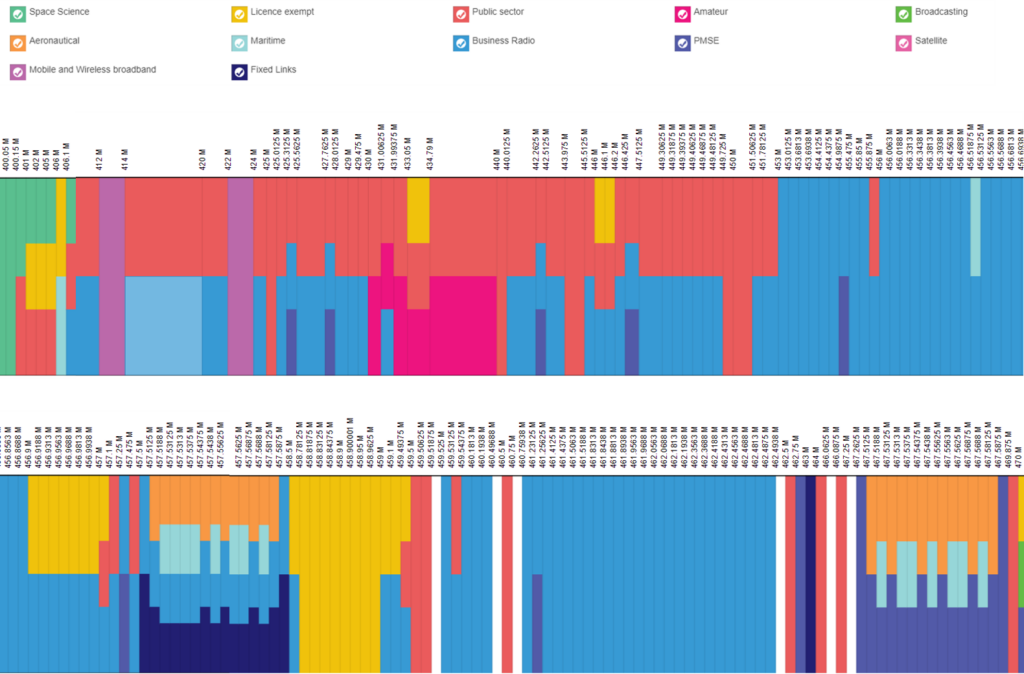
Illustrating diversity and fragmentation of current UK 420-470MHz spectrum, by user (frequency/bandwidth not to scale), March 2021 [2]
“Between neighbouring regulatory regions, historically there has been little alignment across borders, which can lead to interference issues. This is starting to change! Within Europe for example, CEPT (European Conference of Postal and Telecommunications) manages recommendations on how frequencies are used, and supports coordination agreements with neighbouring countries. Lack of alignment on frequency use adds to the complexity of developing equipment compliant with the needs of divergent territories, for example, UK and EU.”
“Historically, some parts of the world assigned 450 MHz band to analog mobile, and then later adopted for CDMA. Once widely used around the world, a mature ecosystem still exists for CDMA technology, but it is now heading towards the end of its lifecycle.”
“Since 2019, these very low frequencies have gained interest in Europe especially around their use in 4G-based LTE networks for IoT and critical communications, including PMR, thanks to their excellent propagation characteristics, making them particularly useful for delivering coverage over long distances in rural areas.”
“Standardisation and operationalisation of this technology has been a focal point for the 450 MHz Alliance for years, with LTE becoming the natural and future-proof successor, particularly for IoT. The members of the 450 MHz Alliance are driving the creation of a new mobile ecosystem and bringing together carriers, spectrum owners as well as equipment, terminal and solution vendors to drive the development of mobile networks in the 450 MHz frequency band worldwide.”
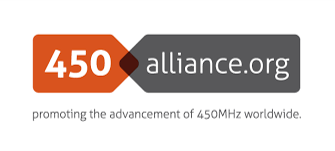
Standardisation has been progressed by the international telecoms standards body, 3GPP RAN, which approved two new bands in the 400 MHz+ frequency range at its 84th Plenary Meeting (3rd-6th June, 2019 in Newport Beach, California),
- Band 87, uplink 410-415 MHz and downlink 420-425 MHz
- Band 88, uplink 412-417 MHz and downlink 422-427 MHz
“This was a significant step forward in the 400 MHz band’s harmonized production of chipsets, modules, devices, and network equipment. Bands 31, 72, and 73, which are located between 450 and 470 MHz, were also specified by 3GPP RAN in previous years,” Amr explained.

A complete picture of the 400 MHz frequency range [3]
“Band 450MHz is limited to a maximum 5 MHz channel size, the maximum practical due to the 450 MHz band’s large wavelength. The band supports up to a 5 MHz carrier in 2×2, providing up to 37 Mb/s of total channel capacity and connectivity beyond 100 kilometres.”
At the end of 2020, the 450 MHz Alliance reported that there were 125 devices supporting 450 MHz (Band 31, 0% of which were phones). Network deployment stats were reported for 380MHz, 410MHz and 450MHz combined: 74 countries globally, with consultations underway in a further 13 countries. [4]
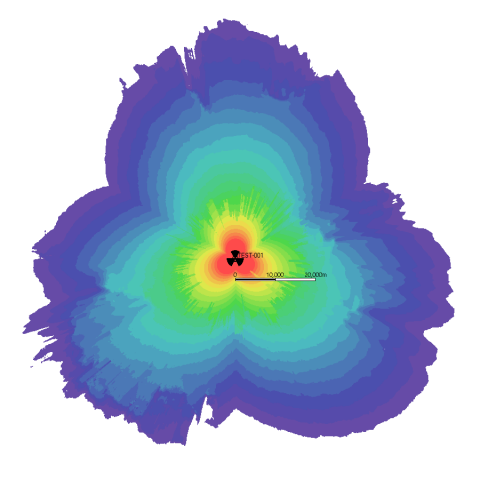
Commercial deployments
“The 400MHz spectrums have a low frequency and wide coverage range, making them commercially suitable for SCADA, LV tracking, smart grids, water monitoring, and remote installations in substations for many IoT/M2M applications.”
“An example of such a commercial use case is found in the four German electricity transmission system operators, who have recently made a case for the energy sector to be allocated 450 MHz LTE mobile radio bands. To address the challenge of incorporating millions of new decentralised producers and users into the grid, such as electric cars and heat pumps, while retaining network reliability, they propose using 450 MHz LTE bands, and compare it the implementation already in place for emergency services who use LTE-capable frequency bands (eg, 700 MHz).” [6]
“In Ireland, ESB Networks have already successfully acquired the rights for 2x 4MHz of spectrum in Band 87 of 410MHz, to facilitate “transformation to a low carbon electricity system through smart technologies” and help it “deliver a more secure, reliable and sustainable electricity network.” [7]
“Additionally, 2020 saw the launch of the first LTE 450MHz Cat1 NB-IoT smart meters, utilizing the in-building penetration, lower network operating communication costs that 450MHz LTE brings to address this large commercial opportunity.” [8]
“For the first time, M2M applications for PMR/PAMR use cases, such as those for operators of critical infrastructure in electricity, transportation, and health, presented a forecast on volumes in the millions, if not tens of millions. This has provided the catalyst the major chipset and module vendors needed to commit to 450 MHz. Additionally, dedicated 450 MHz push-to-talk phones enable voice and community communication, providing a highly resilient solution for emergency communications.”
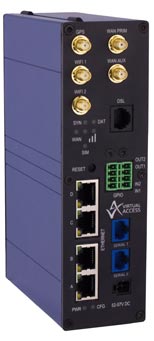
Several European countries have recently allocated spectrum in the 410–430 MHz range to essential communications by Electricity Grid Operators or PPDR (Ireland, Poland, Czech Republic).
As Amr explains, “These ongoing actions at standardisation bodies, in tandem with the work of commercial companies such as the power transmission businesses in Germany, and device manufacturers, will definitely boost ecosystem development in this frequency range. We are seeing more and more interest in this technology to efficiently and reliably deliver IoT communications, both in-buildings and rural areas.”
How do you test in the LTE 400MHz-450MHz band?
“Given the absence of mobile handset support for this band currently, traditional network testing and optimisation solutions will struggle to be able to test in this band,” explains Amr. “However, at Digis Squared, the INOS IoT kits already support LTE 450MHz, as they utilise Quectel BG95-M4 chipsets.”
Developed in-house by Digis Squared, INOS is an intelligent, automated testing, benchmarking and analysis platform for network operators and service providers, delivering drive testing (DT), in-building solution (IBS) capability, end to end IoT system testing, and much more, whilst decreasing both the time taken to complete the work and opex cost.
“We are therefore able to immediately support clients who wish to test and optimise LTE 450MHz IoT implementations, as well as CSPs who wish to ensure their network is fully optimised, or want to include this frequency in their drive testing and IBS assessments.”
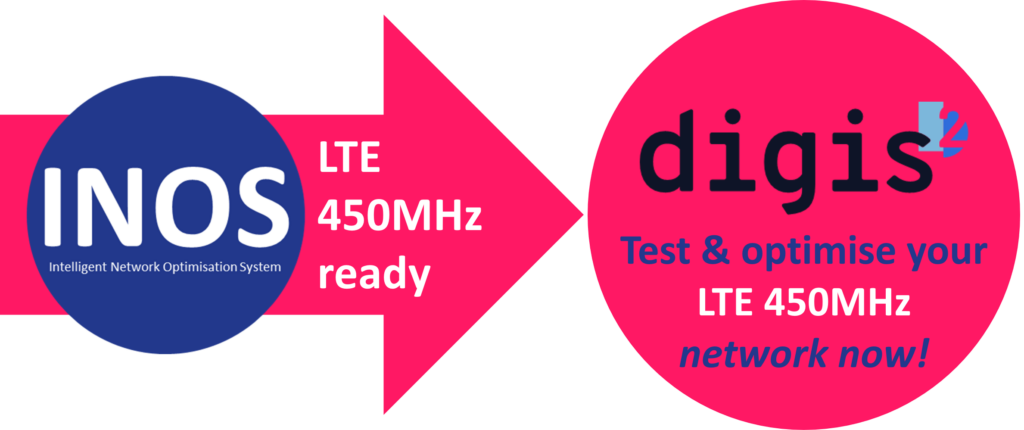
In conversation with Amr Ashraf, Digis Squared 5G & LTE RAN & Software Solution Architect, and Trainer.
LTE 450MHz optimisation & INOS
Our team can help yours with,
- Support or consultation on how to deploy, test or re-farm LTE 450 MHz frequencies
- LTE 450MHz optimisation
- Using INOS in your network deployment or benchmarking
Please get in touch: use this link or email sales@DigisSquared.com .
Discover more about INOS, and INOS for 5G.
Keep up to speed with company updates, product launches and our quarterly newsletter, sign up here.
Digis Squared, independent telecoms expertise.
Sources,
- Down To Earth Electromagnetic Spectrum Infographic, + updated for 5G etc by Digis Squared
- Ofcom (UK) current UK configuration of 420-470MHz, 9 March 2021
- 450MHz Alliance More bands in 400 MHz+ frequency range standardised
- 450 MHz Alliance Annual Device Update Report, March 2020
- Halberd Bastion
- Modern Power Systems: World first 450 MHz private wireless LTE network for DSO (July 2020)
- ESB Networks welcomes award of radio spectrum licence by ComReg
- Sanxing- S34U18 Three Phase Smart Meter
- Virtual Access GW2300 Series
Abbreviations,
- B2B: Business to Business
- B2G: Business to Government
- CSP: communications service provider
- CEPT: European Conference of Postal and Telecommunications
- DT: drive testing
- IBS: in-building solution
- INOS: Intelligent Network Optimisation Solution, a Digis Squared tool
- LV: low voltage
- M2M: machine to machine communications
- PAMR: Public Access Mobile Radio
- PMR: Private Mobile Radio
- PPDR: Public Protection and Disaster Relief radio
- SCADA: Supervisory Control And Data Acquisition, system of software and hardware elements that measure and monitor data in real-time, and control equipment, usually automatically, remotely.
Image credits: Karsten Würth, windmills at Biedesheim, Germany.

